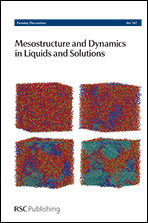A comparative study on bulk and nanoconfined water by time-resolved optical Kerr effect spectroscopy
Abstract
The low frequency (ν < 500 cm−1) vibrational spectra of hydrated porous silica are specifically sensitive to the hydrogen bond interactions and provide a wealth of information on the structural and dynamical properties of the water contained in the pores of the matrix. We investigate systematically this spectral region for a series of Vycor porous silica samples (pore size ≈ 4 nm) at different levels of hydration, from the dry matrix to completely filled pores. The spectra are obtained as the Fourier transforms of time-resolved heterodyne detected optical Kerr effect (HD-OKE) measurements. The comparison of these spectra with that of bulk water enables us to separately extract and analyze the spectral contributions of the first and second hydration layers, as well as that of bulk-like inner water. We conclude that the extra water entering the pores above ≈10% water/silica weight ratio behaves very similarly to bulk water. At lower levels of hydration, corresponding to two complete superficial water layers or less, the H-bond bending and stretching bands, characteristic of the tetrahedral coordination of water in the bulk phase, progressively disappear: clearly in these conditions the H-bond connectivity is very different from that of liquid water. A similar behavior is observed for the structural relaxation times measured from the decay of the time-dependent HD-OKE signal. The value for the inner water is very similar to that of the bulk liquid; that of the first two water layers is definitely longer by a factor ≈4. These findings should be carefully taken into account when employing pore confinement to extend towards lower temperatures the accessible temperature range of supercooled water.
- This article is part of the themed collection: Mesostructure and Dynamics in Liquids and Solutions

 Please wait while we load your content...
Please wait while we load your content...